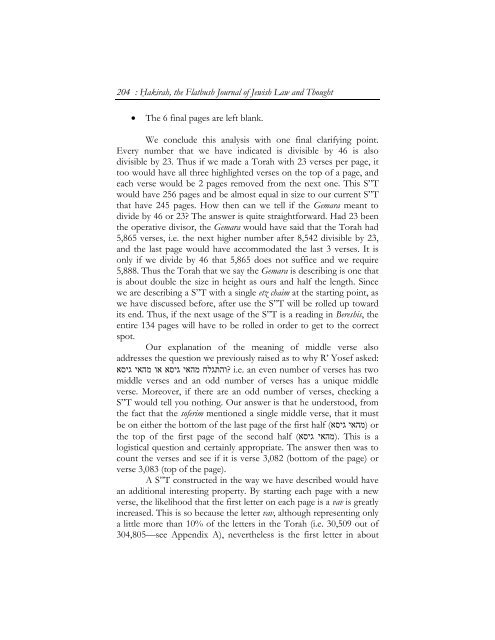Symmetrically Designed Sifrei Torah: A Quantitative Analysis - Hakirah
Symmetrically Designed Sifrei Torah: A Quantitative Analysis - Hakirah
Symmetrically Designed Sifrei Torah: A Quantitative Analysis - Hakirah
You also want an ePaper? Increase the reach of your titles
YUMPU automatically turns print PDFs into web optimized ePapers that Google loves.
204 : Hạkirah, the Flatbush Journal of Jewish Law and Thought<br />
• The 6 final pages are left blank.<br />
We conclude this analysis with one final clarifying point.<br />
Every number that we have indicated is divisible by 46 is also<br />
divisible by 23. Thus if we made a <strong>Torah</strong> with 23 verses per page, it<br />
too would have all three highlighted verses on the top of a page, and<br />
each verse would be 2 pages removed from the next one. This S”T<br />
would have 256 pages and be almost equal in size to our current S”T<br />
that have 245 pages. How then can we tell if the Gemara meant to<br />
divide by 46 or 23? The answer is quite straightforward. Had 23 been<br />
the operative divisor, the Gemara would have said that the <strong>Torah</strong> had<br />
5,865 verses, i.e. the next higher number after 8,542 divisible by 23,<br />
and the last page would have accommodated the last 3 verses. It is<br />
only if we divide by 46 that 5,865 does not suffice and we require<br />
5,888. Thus the <strong>Torah</strong> that we say the Gemara is describing is one that<br />
is about double the size in height as ours and half the length. Since<br />
we are describing a S”T with a single etz chaim at the starting point, as<br />
we have discussed before, after use the S”T will be rolled up toward<br />
its end. Thus, if the next usage of the S”T is a reading in Bereshis, the<br />
entire 134 pages will have to be rolled in order to get to the correct<br />
spot.<br />
Our explanation of the meaning of middle verse also<br />
addresses the question we previously raised as to why R’ Yosef asked:<br />
i.e. an even number of verses has two ?והתגלח מהאי גיסא או מהאי גיסא<br />
middle verses and an odd number of verses has a unique middle<br />
verse. Moreover, if there are an odd number of verses, checking a<br />
S”T would tell you nothing. Our answer is that he understood, from<br />
the fact that the soferim mentioned a single middle verse, that it must<br />
be on either the bottom of the last page of the first half גיסא) (מהאי or<br />
the top of the first page of the second half גיסא) .(מהאי This is a<br />
logistical question and certainly appropriate. The answer then was to<br />
count the verses and see if it is verse 3,082 (bottom of the page) or<br />
verse 3,083 (top of the page).<br />
A S”T constructed in the way we have described would have<br />
an additional interesting property. By starting each page with a new<br />
verse, the likelihood that the first letter on each page is a vav is greatly<br />
increased. This is so because the letter vav, although representing only<br />
a little more than 10% of the letters in the <strong>Torah</strong> (i.e. 30,509 out of<br />
304,805—see Appendix A), nevertheless is the first letter in about
















